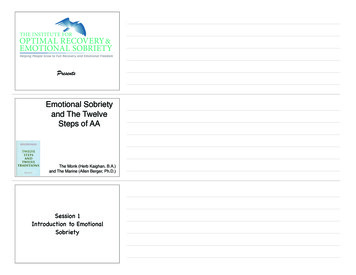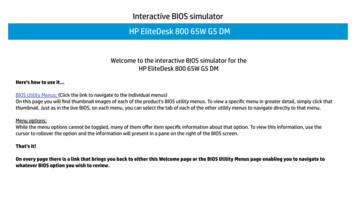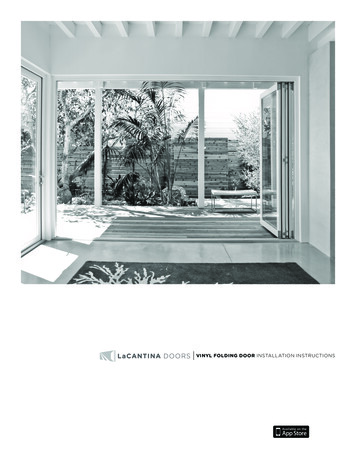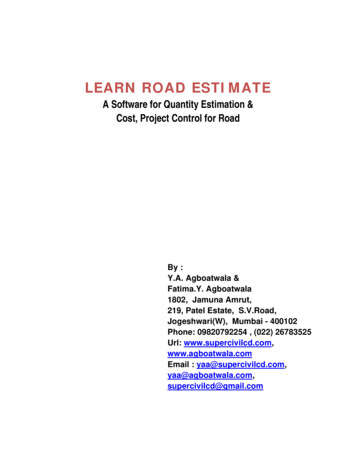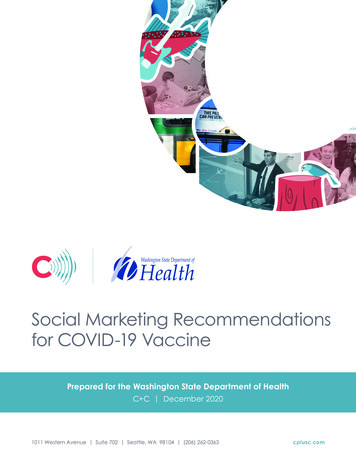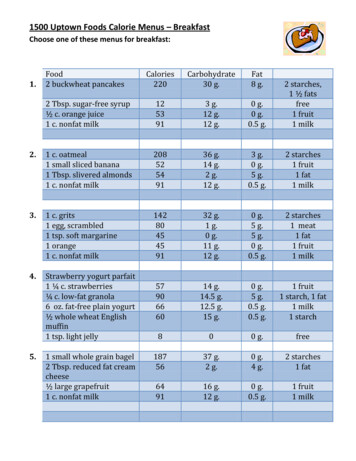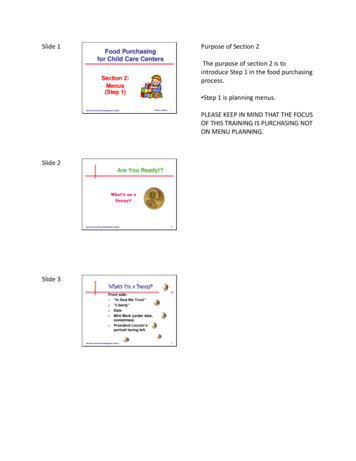
Transcription
Slide 1Purpose of Section 2Food Purchasingfor Child Care CentersThe purpose of section 2 is tointroduce Step 1 in the food purchasingprocess.Section 2:Menus(Step 1)National Food Service Management Institute Step 1 is planning menus.Section 2: Menus1PLEASE KEEP IN MIND THAT THE FOCUSOF THIS TRAINING IS PURCHASING NOTON MENU PLANNING.Slide 2Are You Ready!?What’s on aPenny?National Food Service Management InstituteSlide 32What’s On a Penny?Front side:1.“In God We Trust”2.“Liberty”3.Date4.Mint Mark (under date,sometimes)5.President Lincoln’sportrait facing left.National Food Service Management Institute3
Slide 4What’s On a Penny?Back side:1.“United States ofAmerica”2.“One Cent”3.“E Pluribus Unum”4.Lincoln Memorial (12columns)5.Lincoln Statue in middleof columnsNational Food Service Management InstituteSlide 54What’s On a Penny?General:1.It is copper colored2.The rim around the edge on both sides israised3.The front & back are inverted withrespect to each other4.The diameter is ¾ inch5.The thickness is approximately 1/16 inch6.Its weight is approximately 1/6 ounce.7.The external rim is smooth on theoutside.National Food Service Management Institute5Slide 6Remember PenniesMake Dollars!National Food Service Management Institute6
Slide 7Section 2 Menus Has two objectivesLesson ObjectivesThe learner will be able to explain why planning menus is thefirst step in the food purchasingprocess and state three resources for planningmenus.National Food Service Management InstituteSection 2: Menus7Slide 8We will be able to: explain why planning menus is thefirst step in the food purchasingprocess and state three resources for planningmenus.You must first plan your menus beforebuying your food.Menus (Step 1)First Plan the menusbeforebuying food.National Food Service Management InstituteSection 2: Menus8 Emphasize that you should never buyfood and then try to find a place for iton the menus.Slide 9Never . . . . . buy food and then try tofind a place for it on themenus.National Food Service Management InstituteSection 2: Menus This course will not provide detailedinformation on menu planning.9 If you want training on menu planning,contact NFSMI at 800-321-3054 orhttp://www.nfsmi.org. AND request ME as yourTRAINER! This section discusses menus becausemenus determine what food will bepurchased.
Slide 10Menu ResourcesFeeding Infants:A Guide for Usein theChild NutritionProgramsGreat resource for planningmenus for infants –Birth to 11 monthsNational Food Service Management InstituteSection 2: Menus10Menu Resources There are three resources that canhelp in planning menus appropriate forthe Child and AdultCare Food Program (CACFP).Note: As you talk about each resource,show a copy to the participants. Whenyou are finished, put the resources on atable accessible to participants duringbreaks. Show this slide and point out that agreat resource for planning menus forinfants (from birth through 11 monthsold) is: Feeding Infants: A Guide forUse in the Child NutritionPrograms (United StatesDepartment of Agriculture,Food and Nutrition Service[USDA/FNS], 2002). Feeding Infants: A Guide for Use in theChild Nutrition Programs can bedownloaded g infants.html
Slide 11Menu ResourcesBuilding Blocksfor Fun andHealthy MealsUseful for planning menusfor children -1 year and upSection 2: MenusNational Food Service Management Institute11Slide 12 Building Blocks for Fun and HealthyMeals (USDA/FNS, 2000) is useful inplanning menus for children 1 year oldand older. A copy of Building Blocks for Fun andHealthy Meals can be found blocks.htmlUSDA Recipes for Child CareMenu ResourcesChild CareRecipes: Foodfor Health andFunOregon –Afternoon session!National Food Service Management InstituteSection 2: Menus12The recipes from the 1999 publicationChild Care Recipes: Food for Health andFun from USDA's Child and Adult CareFood Program have been updated toreflect the changes made in the 2001Food Buying Guide for Child NutritionPrograms.Revised recipes have beenstandardized, edited for consistency,analyzed for nutrient content, andupdated with CCP information based onthe 2005 Food Code Supplement.
Available: Online to all child careprograms and state agencies. Thisresource provides several recipessuitable for children in the CACFP.A copy of Child Care Recipes: Food forHealth and Fun can be obtained e recipes.htmlSlide 13You can obtain copies of these threeresources by contacting your StateAgencies, or you can download copiesfrom the Internet.To get a copy . . . contact your State Agency or checkthese Web sites: http://www.fns.usda.gov/tn/Resources/feeding infants.html s.html http://www.fns.usda.gov/tn/Resources/childcare recipes.html http://www.nfsmi.org/Information/cc recipeindex alpha.htmNational Food Service Management InstituteSection 2: Menus13Ask the participants if they already useany of these three resources. If so, askthem to comment on how they usethem.What are some other resources thatyou use for menus and recipes?Mary place on flip chart paper.
Slide 14All the activities that we do are basedon data from a fictitious child carecenter.Practice Center Name: Oak Street Child CareCenterType: small, independentLocation: a community of10,000Days open: Monday–Friday 52 weeks/yearexcept certain holidaysNational Food Service Management InstituteSection 2: Menus14 Slide 15The name of the Center is OakStreet Child Care CenterOak Street is a small independentcenter that serves up to 146 mealsdaily to infants, children andcaregivers.Oak Street is located in acommunity of 10,000.The Center is open Monday throughFriday, 52 weeks a year, except forcertain holidays.The Center uses Cycle MenusPractice Center Cycle menusCACFP serving sizes forinfants 4–7 months oldinfants 8–11 months old children 1–2 years old children 3–5 years old National Food Service Management InstituteSection 2: Menus15The menus include the CACFP mealpattern serving sizes for infants 4–7 months old infants 8–11 months old children 1–2 years old children 3–5 years oldThe Oak Street Child Care Center doesnot include the CACFP mealpattern serving sizes for infantsfrom birth through 3 months oldand for children 6 through 12 yearsold because the Center does notserve any infants and children inthese age groups.Have copy of Mealtime Memo for ChildCare No.3, 2009 “Using CycleMenus to Control Food Costs”.
Slide 16Oak Street Child Care CenterAge GroupInfants: 4–7 monthsInfants: 8–11 monthsChildren: 1–2 yearsChildren: 3–5 yearsCaregiversTotalsNational Food Service Management InstituteMeals ServedNumberEnrolled Breakfast Lunch Snack1111212226202626151010158111244405056Section 2: Menus16Open your manuals to the chart onPage 7.The chart shows the meals served atthe Center and the number of infants,children and caregivers who eat thesemeals.Oak Street has only one infant enrolledthat is 4-7 months old. This infantattends a full day and eats all of themeals served.The Center has two infants enrolledthat are 8-11 months old. One infantattends half of the day and eats onlylunch and a snack, while the otherinfant attends the full day and eatsbreakfast, lunch, and a snack.The Center has 26 children enrolledthat are 1-2 years ld. Six children attendhalf of the day and eat only lunch and asnack, while 20 attend the full day andeat breakfast, lunch, and a snack.There are 15 children enrolled that are3-5 years old. Ten children attend atthe full day and eat breakfast, lunch,and a snack. Five children attend onlypart of the day and eat only a snack.12 Caregivers work at the Center. Eighteat breakfast, 11 eat lunch, and 12 eata snack.When the total meals served forbreakfast (40), lunch (50), and snack(56) are added, the result is 146, whichis the total number of meals serveddaily to infants, children, and caregiversif all are present.
Slide 17The menus on pages 8-13 in youmanuals are those used for ONE weekby Oak Street Child Care Center.The menus on pages 8-10 are forchildren 1 year old and older and themenus on pages 11-13 are for infants.Pages 8, 9, and 10MenusRecipeswww.nfsmi.org/Information/cc recipe index alpha.htmSection 2: MenusNational Food Service Management Institute17The menus for children 1 year old andolder are found on pages 8-10 of yourmanual.These menus are from Building Blocksfor Fun and Healthy Meals (USDA/FNS,2000)The recipes used in the menus are fromChild Care Recipes: Food For Health andFun (USDA/FNS, 1999) and have beenupdated to reflect new Food BuyingGuide for Child Nutrition Programs(USDA/FNS, 2001) creditinginformation.THESE MENUS MEET THEREQUIREMENTS OF THE CACFP MEALPATTERN FOR CHILDREN.Slide 18Menu for Children: Day 1MealFoodBreakfastChocolate Milk, fluidBagel, cinnamon raisin, enrichedCream CheeseStrawberriesLow fat Yogurt, flavoredPear, freshWaterMilk, fluidMexican Pizza, D-13(1½ oz meat; ½ serving bread; ⅛ cup vegetable)Carrots, raw, stripsDip for Carrots, E-15WatermelonSnackLunchNational Food Service Management InstituteServing Sizes:Ages 1–2Serving Sizes:Ages 3–5½ cup½ serving (.5 oz)1 Tbsp¼ cup2 oz½ cup¾ cup½ serving (.5 oz)1 Tbsp½ cup2 oz½ cup½ cup¾ cup2 pieces2 pieces⅛ cup2 Tbsp⅛ cup⅛ cup2 Tbsp¼ cupSection 2: Menus18Turn to Page 8 and find the menu forchildren for Day 1The items on this menu are from theBuilding Blocks for Fun and HealthyMeals (USDA/FNS, 2000)The Serving sizes indicated at the sideof the menu are those required by theCACFP meal pattern for children.Read over the menu items: Breakfast Chocolate milk, fluid Bagel, cinnamon raisin Cream cheese Strawberries
Snack Low fat Yogurt, flavored Pear, fresh Water Lunch Milk, fluid Mexican pizza Carrots, raw, strips Dip for carrots WatermelonThe fluid milk served with this menuand the other menus on pages 8-10 willbe 1% or whole, as appropriate for theage of the child. Children under 2 years old willbe served whole milk. Children 2 years old and olderwill be served 1% milk.Slide 19Menu for Children: Day 1MealFoodBreakfastChocolate Milk, fluidBagel, cinnamon raisin, enrichedCream CheeseStrawberriesLow fat Yogurt, flavoredPear, freshWaterMilk, fluidMexican Pizza, D-13(1½ oz meat; ½ serving bread; ⅛ cup vegetable)Carrots, raw, stripsDip for Carrots, E-15WatermelonSnackLunchNational Food Service Management InstituteServing Sizes:Ages 1–2Serving Sizes:Ages 3–5½ cup½ serving (.5 oz)1 Tbsp¼ cup2 oz½ cup¾ cup½ serving (.5 oz)1 Tbsp½ cup2 oz½ cup½ cup¾ cup2 pieces2 pieces⅛ cup2 Tbsp⅛ cup⅛ cup2 Tbsp¼ cupSection 2: Menus19Please take note of the letters andnumbers next to some menu items. Forexample, D-13 next to Mexican Pizzarefers to the recipes from Child CareRecipes: Food for Health and Fun(USDA/FNS, 1999).See Mexican Pizza Recipe handout.Back on the slide – note the words inparentheses after a recipe explain howthe recipe meets CACFP meal patternrequirements. For example, MexicanPizza contributes 1 ½ ounces of meat, ½serving of bread, and 1/8 cup ofvegetable toward the CACFP lunchrequirements for children.
Slide 20Page 8 – see the menu for day 2.Menu for Children: Day 2Menus are from Building Blocks for Fun andHealthy Meals USDA/FNS,2000)MealFoodBreakfastMilk, fluidApricot Halves, cannedFrench Toast, enrichedSyrupMargarinePeach Slices, cannedGraham Crackers, enrichedPeanut Butter Dip, G-1WaterMilk, fluidSnackLunchServing Sizes:Ages 1–2½ cup¼ cup½ serving (1.1 oz)1 Tbsp1 tsp½ cup½ serving (.5 oz)1 TbspServing Sizes:Ages 3–5¾ cup½ cup½ serving (1.1 oz)1 Tbsp1 tsp½ cup½ serving (.5 oz)1 Tbsp½ cup¾ cupTeriyaki Chicken, D-12 (1½ oz chicken)1 portion1 portionStir-Fry Vegetables, I-10Not Fried Rice, A-8 (⅛ cup vegetable; ½ serving bread;¼ egg or ½ oz meat)Fresh Fruit Cup⅛ cup (⅛ cup veg)¼ cup (¼ cup veg)⅜ cup⅜ cup⅛ cup⅛ cupSection 2: MenusNational Food Service Management Institute20Slide 21Menu for Children: Day 3MealFoodServing Sizes:Ages 1–2Serving Sizes:Ages 3–5BreakfastMilk, fluid½ cup¾ cupBanana½ cup½ cupRaisin Bread, toasted, enriched½ slice (.5 oz)½ slice (.5 oz)Margarine1 tsp1 tspOrange Juice½ cup½ cupMuffin Square, A-11½ serving½ servingMilk, fluid½ cup¾ cupBBQ Beef Sandwich, F-8(1½ oz beef; ⅛ cup vegetable; 1 serving bread)½ sandwich½ sandwichColeslaw, E-9 (⅛ cup vegetable)⅛ cupTomatoes, sliced⅛ cupSnackLunchNational Food Service Management Institute⅛ cup¼ cupSection 2: Menus21The items on this menu are from page98 of Building Blocks for Fun andHealthy Meals (USDA/FNS, 2000).The menu items are: Breakfast Milk, fluid Apricot Halves, canned French Toast, enriched Syrup Margarine Snack Peach Slices, canned Graham Crackers, enriched Peanut Butter Dip, G-1 Water Lunch Milk, fluid Teriyaki Chicken, D-12 (1½ oz.chicken) Stir-Fry Vegetables, I-10 Not Fried Rice, A-8 (⅛ cupvegetable; ½ serving bread; ¼egg or ½ oz. meat) Fresh Fruit CupPage 9 of your manualsBreakfastMilk, fluidBananaRaisin Bread, toasted, enrichedMargarineSnackOrange JuiceMuffin Square, A-11LunchMilk, fluidBBQ Beef Sandwich, F-8(1½ oz. beef; ⅛ cup vegetable; 1 servingbread)
Coleslaw, E-9 (⅛ cup vegetable)Tomatoes, slicedSlide 22Menu for Children: Day 4MealFoodBreakfastMilk, fluidOrange SectionsPancake, A-12Maple Applesauce Topping, C-1 (¼ cup fruit)Chocolate Milk, fluidAnimal Crackers, enrichedMilk, fluidPeanut Butter Sandwich[1½ Tbsp peanut butter on ½ serving (.5 oz) bread]SnackLunchBroccoli Cheese Soup, H-5Pineapple Cubes, in juiceNational Food Service Management InstituteServing Sizes:Ages 1–2½ cup¼ cup½ serving (.6 oz)¼ cup½ cup½ serving (.5oz)½ cupServing Sizes:Ages 3–5¾ cup¼ cup½ serving (.6 oz)¼ cup½ cup½ serving (.5 oz)¾ cup1 serving1 serving¼ cup(⅜ oz cheese;⅛ cup vegetable)⅛ cup½ cup(¾ oz cheese;¼ cup vegetable)¼ cupSection 2: Menus22Turn to page 9.Here is the menu for DAY 4:BREAKFASTMilk, fluidOrange SectionsPancake, A-12Maple Applesauce Topping, C-1 (¼ cupfruit)SNACKChocolate Milk, fluidAnimal Crackers, enrichedLUNCHMilk, fluidPeanut Butter Sandwich[1½ Tbsp. peanut butter on ½ serving(.5 oz.) bread]Broccoli Cheese Soup, H-5Pineapple Cubes, in juice
Slide 23Page 10 of your manuals is the Menufor DAY 5:Menu for Children: Day 5MealFoodServing Sizes:Ages 1–2Serving Sizes:Ages 3–5BreakfastMilk, fluid½ cup¾ cupApple Wedges¼ cup½ cupEnglish Muffin, whole wheat, toasted,enriched½ serving (.5 oz)½ serving (.5 oz)Jam1 tsp1 tspWheat Crackers, enriched½ serving (.4 oz)½ serving (.4 oz)Grape Juice½ cup½ cupChocolate Milk, fluid½ cup¾ cupTuna Patty, D-10(1½ oz fish; ½ serving bread)1 patty1 pattyOven Fries, I-51 piece(⅛ cup vegetable)3 pieces(⅜ cup vegetable)Green Beans⅛ cup⅛ cupSnackLunchNational Food Service Management InstituteSection 2: MenusThis menu is from page 104 of BuildingBlocks for Fun and Healthy Meals(USDA/FNS, 2000).23Slide 24Pages 11, 12, and 13National Food Service Management InstituteSection 2: Menus24BREAKFASTMilk, fluidApple WedgesEnglish Muffin, whole wheat, toasted,enrichedJamSNACKWheat Crackers, enrichedGrape JuiceLUNCHChocolate Milk, fluidTuna Patty, D-10(1½ oz. fish; ½ serving bread)Oven Fries, I-5Green BeansThe menus for infants on pages11,12,13 of your manual Are based on information fromchapters 7 and 11 of FeedingInfants: A Guide for Use in theChild Nutrition Program(USDA/FNS, 2002) and Meet the requirements of theCACFP meal pattern for infants. Copies of Chapter 7 & 11 of FeedingInfants: A Guide for Use in the ChildNutrition Program is available perindividual or per table. Let’s look overthe two chapters from Feeding Infants. Do you have any questions? Do you think you may utilize thisresource?
Please keep in mind that this trainingis focusing on purchasing and not menuplanning. The infants at Oak Street Child CareCenter were previously introduced toand accepted the foods offered on themenus on Pages 11-13. In other words,these menus do not contain foods thatthe infants will be eating for the firsttime.Slide 25Menu for Infants: Day 1MealFoodServing Sizes:4–7 MonthsServing Sizes:8–11 MonthsBreakfastBreast Milk or Formula, iron-fortified14–8 fl oz6–8 fl ozInfant Rice Cereal, iron-fortified2,60–3 Tbsp2–4 TbspPeaches, in a jar3,6Snack1–4 TbspBreast Milk or Formula, iron-fortified14–6 fl ozCrackers, whole-grain4,5,6LunchBreast Milk or Formula,iron-fortified1Infant Rice Cereal, iron-fortified2,60–2 crackers4–8 fl oz6–8 fl oz0–3 Tbsp2–4 TbspStrained Turkey, in a jar6Carrots, in ajar3,6National Food Service Management Institute2–4 fl oz1–4 Tbsp0–3 Tbsp1–4 TbspSection 2: Menus25Open your manuals to page 11 andlocate the menu for infants for Day 1.The serving sizes indicated at the sideof the menu are those required by theCACFP meal pattern for infants.Breast milk or iron-fortified formula ison the menu for breakfast, snack, andlunch. 2 of the 3 infants attending Oak StreetChild Care Center receive breast milkprovided by their mothers. The other infant receives iron-fortifiedformula by the Center. Infant rice cereal is on the menu forbreakfast and lunch. The infants at the center aredevelopmentally ready to eat ironfortified infant cereal. Peaches in a jar are on the menu forbreakfast, while carrots in a jar are onthe menu for lunch. “In the jar” refers to commerciallyprepared baby food. The CACFP requires that the firstingredient in jarred fruits andvegetables be the actual fruit orvegetable.
All the infants at the Center aredevelopmentally ready to eatcommercially prepare fruits andvegetables. “Strained Turkey in a jar” is on themenu for lunch. This refers tocommercially prepare baby food. It isserved only to infants 8-11 months oldas indicated in the CACFP meal patternfor infants. Crackers are on the menu for snack.They are whole grain because theCACFP meal pattern for infants requiresthat crackers be made from wholegrain or enriched meal or flour. The CACFP meal pattern indicates, thecrackers are served only to infants 8-11months old.Slide 26Moving on to Section 3Section 3:Grocery List(Step 2)National Food Service Management InstituteSection 2: Menus26
National Food Service Management Institute Section 2: Menus 1 Food Purchasing for Child Care Centers Section 2: Menus (Step 1) Purpose of Section 2 The purpose of section 2 is to introduce Step 1 in the food purchasing process. Step 1 is planning menus. PLEASE KEEP IN MIND THAT THE FOCUS OF THIS TRAINING IS PURCHASING NOT ON MENU PLANNING.
